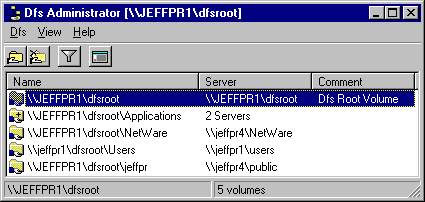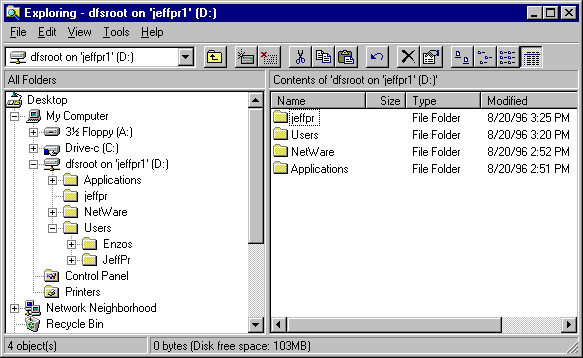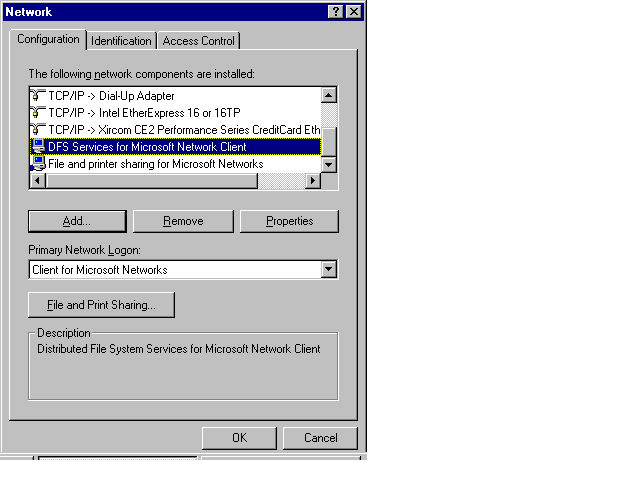
Flexible Administration
Dfs provides a useful tool for reducing the complexity of managing an ever-changing server configuration. As old servers are retired, groups of servers are consolidated into more powerful servers, and new servers are brought on line for the ever-growing storage requirements. In principle, administrators should be required to manage fewer and fewer servers and to more easily keep up with new technology as it becomes available.
Dfs allows administrators to build hierarchical directories that span multiple file servers and file shares. Dfs includes an easy-to-use administration tool that makes it simple for network managers to build and maintain Dfs directories. Dfs also includes a scriptable command line administration tool. Dfs is easy to manage because no new tools are required for most management tasks. File security is managed using the Windows NT Server security model via the Windows Explorer.

Figure 1: Dfs Administrator, managing a Dfs volume
Dfs makes it easy for network managers to replace servers. Each node in the Dfs directory tree is assigned a logical name that points to a file share. The Dfs node can be switched to point to a new server while the old server is taken off line. Users will never know that they are using a different server, since the Dfs directory tree does not change.
Easy Browsing of File Servers
Dfs makes it easy to create a single directory tree that includes multiple file servers and file shares in a group, division, or enterprise. Dfs gives the user a single directory that can span a vast number of file servers and file shares, making it easy to "browse" the network to find the data and files needed. Browsing the Dfs directory is easy because Dfs sub-directories can be assigned logical, descriptive names, no matter what the name of the actual file server/file share is.

Figure 2: Browsing the Dfs volume shown in Figure 1
Dfs directories make it easy for a group to organize all the relevant file shares into a single Dfs Directory tree. Server-level Dfs directories can be combined into a hierarchical Dfs directory, constrained only by the limit of 260 characters per file path.
Simple Searches for Files or Data
Dfs makes it easy to find data and files because the file search tools included in Windows 95 and Windows NT Workstation, or even your word processor, can now search for a specific file that can be located on any server in the Dfs directory tree.
With Windows 95 and Windows NT Workstation, Dfs makes large, distributed networks easier to use. Instead of having to deal with multiple persistent network connections to separate physical file servers, each user only needs one or more persistent network connections to their Dfs trees.
Better Data Availability and Load Balancing
Dfs can also provide enhanced data availability by pointing to multiple volumes which can be alternates of each other. If one is unavailable, Dfs will hand off to the alternate one. This also provides a performance gain because Dfs can distribute client accesses to Dfs volumes evenly across multiple alternate network shares. If 300 users require access to one volume, Dfs can split the users among copies on two or more servers to balance the load.
Name and Location Transparency
Dfs transparently links server volumes and shares into a single name space, providing name transparency. This helps administrators by simplifying growth and administration of the network through centralized management.
Name transparency eliminates the need for end users to know where information is physically stored. This is a particular advantage in large organizations, which may have many areas where information is stored. Dfs allows a user to find a particular piece of information within a meaningful hierarchy without having to know where (or on which machine) it is stored.
The location transparency of Dfs eases the burden of upgrading to new machines by allowing additional storage to be published in sub-directories. Because users don't need to know the name of a server or share, administrators can physically move user information to another server without the need to re-educate users (or reconfigure applications and shortcuts) about how they can find their data. Additional or higher performance servers can be added without the name being changed. Dfs will allow one share to span multiple servers; these machines would be presented as new directories within the share.
Flexible Internet and Intranet Management
Dfs simplifies deployment of Internet and intranet solutions. A Web master can now build a logical Dfs directory that includes the default Web pages of each department's Web server as a sub-directory of the main Internet or intranet Web. This allows each department or group to retain control over their unique intranet content and applications, while the user only sees a single, unified Internet site or intranet.
Dfs works with the built-in Internet Information Server of Windows NT Server. The HTML links to other pages stored in Dfs do not have to be updated if the initial page is physically moved from one server to another, provided an administrator reconfigures Dfs accordingly. This allows a user with an Internet page to publish it: if the server hosting that page is removed and the page is republished in a different location, all links pointing to that page will not have to be reconfigured.
Integration with Windows 95 and Windows NT Workstation Clients

Figure 3: Installing the Dfs service for Windows 95
Dfs support is already included in Windows NT Workstation 4.0, and support for Windows 95 is included in the Dfs release. Dfs can make Windows 95 and Windows NT Workstation desktops even easier to use by eliminating the need for multiple persistent network connections to individual physical servers. Also, workstation shares may participate in the server-based Dfs volume, making it easy to share desktop files with others and helping network administrators extend corporate file maintenance down to desktops. Additionally, with the Windows NT Client for Dfs, you can Net Use below the \\server\Share level.
Simplified File Maintenance Tasks
Dfs makes file maintenance tasks such as enterprise backups easy. Since a single Dfs tree can be built to cover a large number of servers, the backup software can back up this single "tree," no matter how many servers/shares are part of the Dfs. Dfs can also make backups of data on end-user systems easy. Since Windows 95 and Windows NT Workstation systems can be "leaves" in a Dfs tree, a Dfs tree can include all the directories on users' desktops that network managers want backed up. Other file maintenance tasks that Dfs can help simplify include scanning for viruses across an entire network and content indexing of data for use with search tools, such as Microsoft Index Server.
Care must be taken to have the Dfs tree in place before doing a restore, as Dfs is transparent to almost all backup utilities available today.